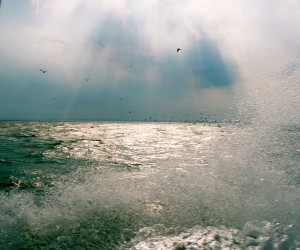asmfc
I could hear the excitement in my fishing partner, Jamie Clough’s voice as he scanned the cloudy Chesapeake horizon with his binoculars.”
“Big birds!”
I slammed my 27′ Judge Center Console into gear and Thunder Road was off to the races. Up ahead, through the misty rain, we could see big herring gulls as they swooped and circled high over the water. As if on cue, a group of six or eight birds plunged toward a swirl on the surface. A savage fight ensued and the victor flew away erratically as the other gulls gave chase. In the lead bird’s beak was a 6-inch long silver fish.
“They’re on big bunker. That’s what we’re looking for,” shouted Jamie.
We bolted toward the spot where the birds were diving with our rods and reels at the ready. Before the boat came to a complete stop, we were both hooked up.
“Fish on!”
How was your fishing this fall? By most accounts, it’s been a great season for light tackle casting on the Chesapeake Bay. One of the reasons why we’re catching more fish than ever this year is that, thanks to recent harvest reductions, there is a lot of bait around, especially menhaden. In the Chesapeake, anglers refer to menhaden as bunker or sometimes (incorrectly) LYs. They’ve famously been called, “the most important fish in the sea.” That’s because menhaden are such a critical link in the Atlantic’s food web. At one time, menhaden made up over 70% of rockfish diets. Now, that number has dwindled to something like 8% because there just isn’t enough menhaden to keep the rockfish fed. In fact, the population of menhaden in the Atlantic Ocean is at less than 10% of historic levels. That’s a big drop and a huge problem, not only for recreational fishermen, but for anyone who makes their living in and around the Bay. Read More!
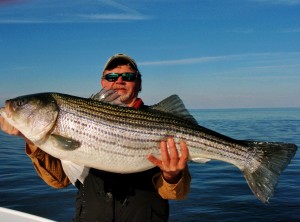 I may have found the best fishing spot in the Chesapeake Bay. I discovered it completely by accident a few years ago. I was zig-zagging across some ledges in the Mid-Bay when I saw something on my fish finder that looked like a miniature underwater forest. My first thought was that I was seeing small tree trunks or the remains of fence posts coming up from the bottom. Then I thought maybe I was seeing a shipwreck, but the more I explored the area, the more it became apparent that my sonar was pinging over more natural structure. I was seeing the sonar returns of oysters, and lots of them.
I may have found the best fishing spot in the Chesapeake Bay. I discovered it completely by accident a few years ago. I was zig-zagging across some ledges in the Mid-Bay when I saw something on my fish finder that looked like a miniature underwater forest. My first thought was that I was seeing small tree trunks or the remains of fence posts coming up from the bottom. Then I thought maybe I was seeing a shipwreck, but the more I explored the area, the more it became apparent that my sonar was pinging over more natural structure. I was seeing the sonar returns of oysters, and lots of them.
When oysters are left to grow, they form highly complex and irregular reefs. This is a result of the natural reproduction process by which larvae is set onto existing shells. These new shells clump together with older ones, and grow upward toward the surface. When the reefs go unharvested, they grow into mounds or plumes. When they’re left alone for a long time, the mounds can reach the surface of the water and be visible at low tides. In regions where oysters are plentiful, they call these mounds “oyster rocks.” That’s a term you don’t hear too much in Maryland because there aren’t any oyster rocks left. Read More!
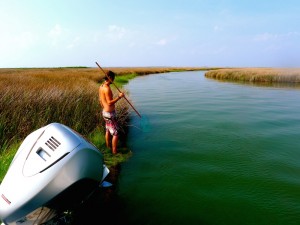 I hang with a lot of fisheries guys. If I had to guess at the backgrounds of the people I’ve fished with most frequently, it would be (in order) coaching baseball, cutting meat, and studying fish. My brother is a fisheries biologist as are many of my friends. I was thrilled recently when a young fisherman who is still in high school reached out to me about his career plans, “I want to be a fish scientist,” he said. “I want to make a difference.” Obviously, I appreciate those guys and the science in which they work.
I hang with a lot of fisheries guys. If I had to guess at the backgrounds of the people I’ve fished with most frequently, it would be (in order) coaching baseball, cutting meat, and studying fish. My brother is a fisheries biologist as are many of my friends. I was thrilled recently when a young fisherman who is still in high school reached out to me about his career plans, “I want to be a fish scientist,” he said. “I want to make a difference.” Obviously, I appreciate those guys and the science in which they work.
I looked up the term Fisheries Management and found this: Fisheries management draws on fisheries science in order to find ways to protect fishery resources.
I like the phrase, “draws on fisheries science.” As a fisherman and a conservationist, I want management decisions based on facts, not politics, pseudoscience, or hearsay. I am a student of the collective knowledge acquired by fishermen. There’s nothing I’d rather hear than the recommendations of a seasoned angler or the sage advice of an experienced waterman. On the other hand, I work in a scientific profession, so I recognize that good science trumps folklore on every occasion. Read More!
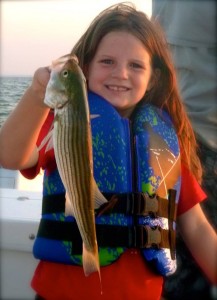 I want to take a few minutes to update everyone on the continuing bizarre actions of The Maryland Department of Natural Resources (DNR) toward striped bass. In my last entry, I reported that, despite pending actions to reduce striped bass harvest by the Atlantic States Marine Fisheries Commission (ASMFC), Chesapeake Bay fisheries managers – including those from the Potomac River and Virginia – have announced plans to increase harvest. They justify this with statistics showing more 18-inch fish in the Bay as a result of the 2011 spawning year class. This flies in the face of pleas from anglers in Maryland and all up and down the Atlantic Seaboard for additional conservation of striped bass. Simply put, at a time when anglers think we should be cutting back on a species in trouble, Chesapeake managers want to kill more.
I want to take a few minutes to update everyone on the continuing bizarre actions of The Maryland Department of Natural Resources (DNR) toward striped bass. In my last entry, I reported that, despite pending actions to reduce striped bass harvest by the Atlantic States Marine Fisheries Commission (ASMFC), Chesapeake Bay fisheries managers – including those from the Potomac River and Virginia – have announced plans to increase harvest. They justify this with statistics showing more 18-inch fish in the Bay as a result of the 2011 spawning year class. This flies in the face of pleas from anglers in Maryland and all up and down the Atlantic Seaboard for additional conservation of striped bass. Simply put, at a time when anglers think we should be cutting back on a species in trouble, Chesapeake managers want to kill more.
The people of Maryland deserve more from the agencies who are charged with protecting their fish. Today, leaders from the Maryland Coastal Conservation Association (CCA) met with Fisheries Director Mr. Thomas O’Connell and others from DNR in an attempt to persuade them to reduce harvest, not increase it. I am not optimistic. There is even talk of reducing conservation buffers in subsequent years so Chesapeake states can continue to harvest at present levels. In other words, they might try to get around ASMFC mandated cuts in 2015 by changing their accounting methods. We all understand the science behind the decision, but just because there are more young fish in the Bay from one successful spawning year doesn’t mean we should kill more, especially when stocks are threatened. I am including a letter CCA delivered below. Read More!
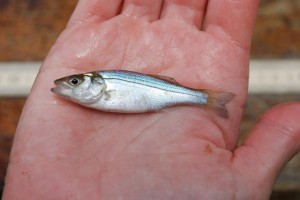 “Let’s kill as many as we can before we have to save them.” That seems to be the attitude of the Maryland Department of Natural Resources. Tuesday, just before closing for a five day Thanksgiving weekend, DNR fisheries dropped a turkey on recreational striped bass anglers by announcing a 14% increase in harvest in the Chesapeake Bay. At a time when striper stocks are steeply declining and states up and down the Atlantic seaboard face impending cuts mandated by the Atlantic States Marine Fisheries Commission (ASMFC), Maryland & Virginia are grabbing more fish. Here’s a link to the press release and a quote:
“Let’s kill as many as we can before we have to save them.” That seems to be the attitude of the Maryland Department of Natural Resources. Tuesday, just before closing for a five day Thanksgiving weekend, DNR fisheries dropped a turkey on recreational striped bass anglers by announcing a 14% increase in harvest in the Chesapeake Bay. At a time when striper stocks are steeply declining and states up and down the Atlantic seaboard face impending cuts mandated by the Atlantic States Marine Fisheries Commission (ASMFC), Maryland & Virginia are grabbing more fish. Here’s a link to the press release and a quote:
Determination of the Available 2014 Chesapeake Bay Commercial Striped Bass Quota
For 2014, it was decided that fishermen could safely harvest 8,652,528 pounds of Striped Bass – without detriment to the Bay population. The previous year’s quota was 7,589,937 pounds and for the first time in many years the quota has been increased in the Bay. This increase of approximately 14% is attributed to a large number of fish from the 2011 year class (fish that hatch and enter into the population in a given year) which are just now reaching the legal minimum size of 18 inches.
I hope you find that as unbelievable as I do. I’ve tried to keep fisheries politics out of this blog lately because I want to concentrate on the fun parts of our sport, but when something this egregious comes out, I think it’s important to spread the news and let our fisheries managers know just how pissed off recreational anglers can be. Read More!
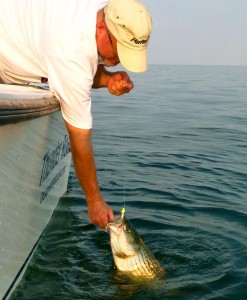 You’ve probably heard by now that the bottom is dropping out of striper fishing. The latest Atlantic States Fisheries Commission (ASMFC) stock assessment shows a population in decline. Don’t be fooled by the first few lines of the report when it says, “Stripers are not overfished and overfishing is not occurring.” They’ve been saying that for years while fishermen all up and down the Atlantic coast have been warning of a crash. Now we have proof. Using the current fishing mortality threshold, we have been overfishing for striped bass five out of the last eight years. If we keep catching at the rate we are now, the fishery will decline rapidly. Concerned fishermen up and down the Atlantic coast agree that harvest reductions should be implemented quickly. Check out this article from Captain John McMurray in New York.
You’ve probably heard by now that the bottom is dropping out of striper fishing. The latest Atlantic States Fisheries Commission (ASMFC) stock assessment shows a population in decline. Don’t be fooled by the first few lines of the report when it says, “Stripers are not overfished and overfishing is not occurring.” They’ve been saying that for years while fishermen all up and down the Atlantic coast have been warning of a crash. Now we have proof. Using the current fishing mortality threshold, we have been overfishing for striped bass five out of the last eight years. If we keep catching at the rate we are now, the fishery will decline rapidly. Concerned fishermen up and down the Atlantic coast agree that harvest reductions should be implemented quickly. Check out this article from Captain John McMurray in New York.
Since striped bass is a highly-sought-after species with big money involved on both the commercial and recreational sides, any reductions will be controversial. I get the sense that there may be some within the ASMFC who believe that the commercial striped bass fishing industry has already sacrificed enough. If that perception spreads, recreational fishing could take the brunt of the reductions. I won’t flesh out the arguments pro and con here, but suffice it to say that I believe cuts are overdue and necessary and should be equal across both sectors.
Commercial fishing aside, disagreements are sure to follow within the recreational community. They will be especially apparent here in the Chesapeake Bay, where the charter boat industry and some fishing clubs rely heavily on fishing revenues from spawning-class stripers during times of the year when they are easiest to catch. It’s sure to get interesting, and I expect blood letting on all sides. Read More!



